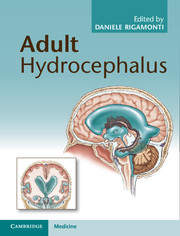Book contents
- Adult Hydrocephalus
- Adult Hydrocephalus
- Copyright page
- Dedication
- Dedication
- Contents
- Contributors
- Prologue
- Section 1 Basic sciences
- Section 2 Pathophysiology
- 6 Pathophysiology of gait dysfunction in normal pressure hydrocephalus
- 7 The pathophysiologic basis of cognitive dysfunction in idiopathic normal pressure hydrocephalus
- 8 Incontinence and lower urinary tract symptoms in normal pressure hydrocephalus
- 9 Normal pressure hydrocephalus grading scales
- Section 3 Diagnosis
- Section 4 Treatment and outcomes
- Section 5 Associated conditions
- Epilogue
- Index
8 - Incontinence and lower urinary tract symptoms in normal pressure hydrocephalus
from Section 2 - Pathophysiology
Published online by Cambridge University Press: 05 February 2014
- Adult Hydrocephalus
- Adult Hydrocephalus
- Copyright page
- Dedication
- Dedication
- Contents
- Contributors
- Prologue
- Section 1 Basic sciences
- Section 2 Pathophysiology
- 6 Pathophysiology of gait dysfunction in normal pressure hydrocephalus
- 7 The pathophysiologic basis of cognitive dysfunction in idiopathic normal pressure hydrocephalus
- 8 Incontinence and lower urinary tract symptoms in normal pressure hydrocephalus
- 9 Normal pressure hydrocephalus grading scales
- Section 3 Diagnosis
- Section 4 Treatment and outcomes
- Section 5 Associated conditions
- Epilogue
- Index
Summary
Keywords
- Type
- Chapter
- Information
- Adult Hydrocephalus , pp. 80 - 90Publisher: Cambridge University PressPrint publication year: 2014
- 1
- Cited by



